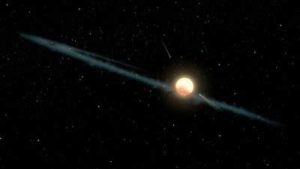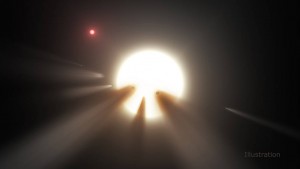Two new studies — one by a group of high school students — are investigating the strange environment around Tabby's Star.

NASA / JPL-Caltech
Once again, KIC 8462852 (aka Tabby's Star or Boyajian's Star) is proving how difficult it is to observe a strange system from afar.
This is the star made famous for potentially hosting alien megastructures. Observations have since firmly ruled out that option, but that aliens were mentioned at all shows just how weird the star is.
Tabby’s Star dips in brightness — sometimes by just 1% and sometimes by up to 20% — over days or weeks, before recovering to its previous luminosity. Yet it's fading too, over longer timescales of years and even decades. Dust explains the short-term dips, but new research shows that the long-term fade could be due to something else entirely.
Tabby's Star: Update
After the discovery of Tabby's Star's strange behavior, astronomers began monitoring the star for variability. When the star's brightness began dipping again last year, observatories around the world joined the monitoring campaign, catching four dips that together are dubbed the "Elsie" family (a play on "LC," short for "light curve"). The other three dips in the family are nicknamed Celeste, Skara Brae, and Angkor; the names are part of the Kickstarter project that funded the observations
Now, two new studies presented at the meeting of the American Astronomical Society in Denver investigated the nature of the dust that’s causing the short-term dips. Both studies compared the dips in different wavebands. As expected from a previous study, the dips are deeper at bluer wavelengths. That’s because it's dust that’s blocking the star’s light — it scatters away the bluer light while letting the red light pass through. (You can see a similar effect at sunset, when the Sun reddens as its light passes through more atmosphere.)
The dips' wavelength dependence was already known, but the two teams took a closer look at the data. A pair of rising seniors at Thacher School in California, Yao Yin and Alejandro Wilcox, presented results regarding the fourth dip seen in 2017, named “Angkor.” They found that the dust grains causing this dip were similar to dust found in the interstellar medium — tiny grains akin to campfire smoke more so than the dust you find in the corners of your house.
Another team led by Eva Bodman (Arizona State University) found similar results for all four dips. The small grain sizes, she says, mean that the dust was newly created — the star’s radiation would have quickly pushed the smoky dust out of the system, so it can’t last long.

Eva Bodman
Bodman also found that the grain size actually changed slightly between dips. “The dust in the cloud isn’t varying in time,” she notes. “We are seeing different parts of the cloud as they cross in front of the star.” That's intriguing — are we seeing the remnants of asteroids of different compositions? Or perhaps a combination of asteroids and comets?

NASA / JPL-Caltech
Because the small grains won't last long in this system, it's not surprising that both teams found that the dust that’s blocking starlight over the short-term bears no resemblance to whatever’s causing the star to fade over the course of decades. The long-term change appears to be caused by much larger or denser dust grains that can withstand the star’s radiation pressure.
But what is the dust and where is it coming from? That’ll have to be a question for another day. While the action does appear to be happening near the star (rather than in interstellar space or in the outer solar system), neither team could speak to what the dust is made of, nor its origin — the observations just aren’t there yet. A more dramatic dip or simply more long-term observations at many different wavelengths will help clarify the story of Tabby’s Star.
 4
4
Comments
Wilber2
August 11, 2018 at 12:14 pm
Hi Monica where can I get a better graphic and "accurate info" of this data? Lots of speculation.
You must be logged in to post a comment.
Monica YoungPost Author
August 11, 2018 at 9:34 pm
Hi Wilber2, it looks like Eva Bodman's study is being submitted to journals, you can find it on the astronomy preprint archive here: https://arxiv.org/abs/1806.08842. I haven't been able to find the Thacher School students' paper online, but you can see the abstract from their AAS presentation here: http://adsabs.harvard.edu/abs/2018AAS...23232504Y.
You must be logged in to post a comment.
Athena66627
August 21, 2018 at 3:48 am
Ya right! It's not dust, we should all know it a dysons sphere, and the government is covering it up.
You must be logged in to post a comment.
mcb123oc
November 6, 2018 at 2:18 am
I know very little, Math, Science, Statistics...a bit about Thermodynamics... But I think everyone should not over-
complicate something that is somewhat obvious. There are other solar systems getting in the way of our observations........
You must be logged in to post a comment.
You must be logged in to post a comment.